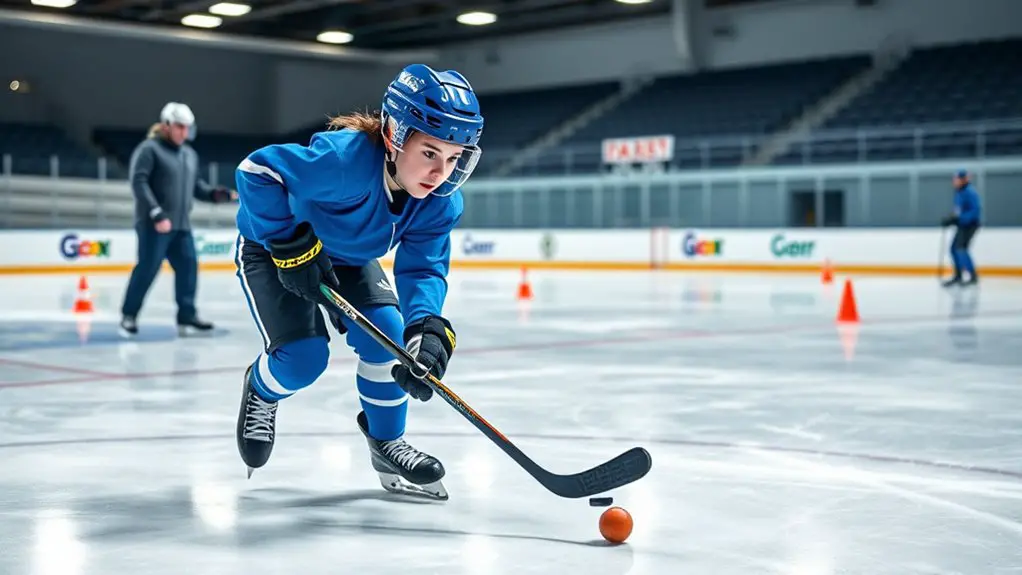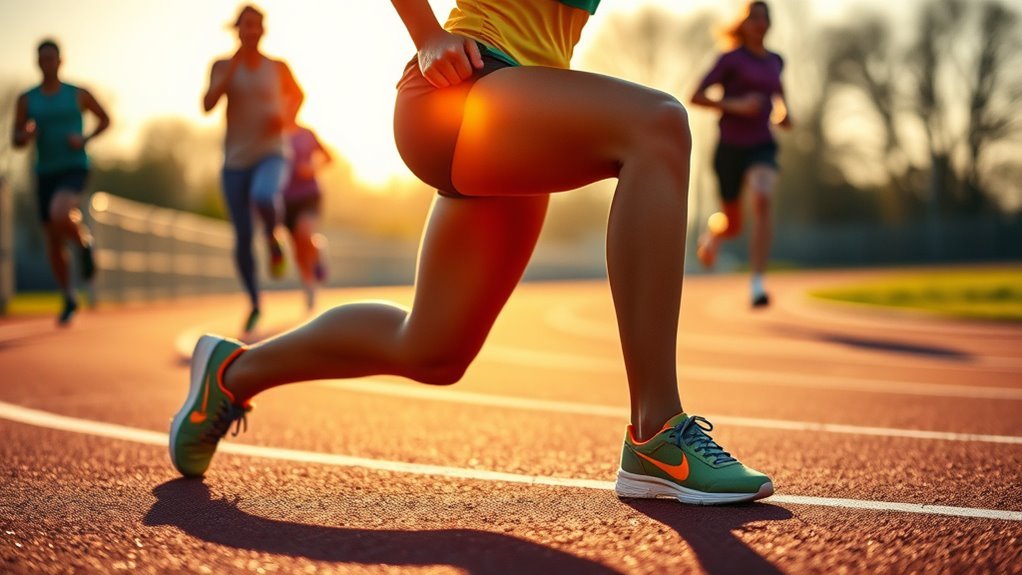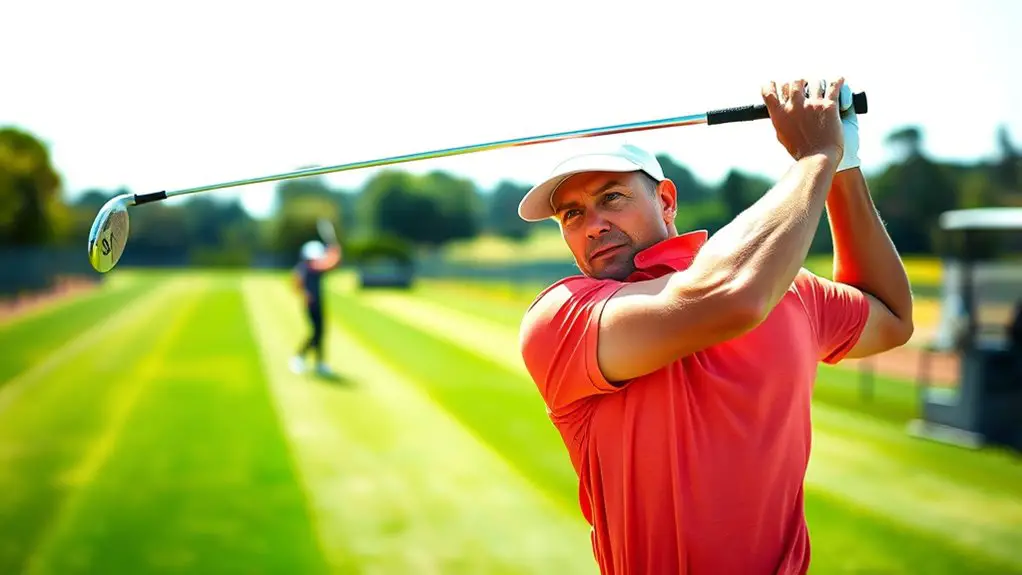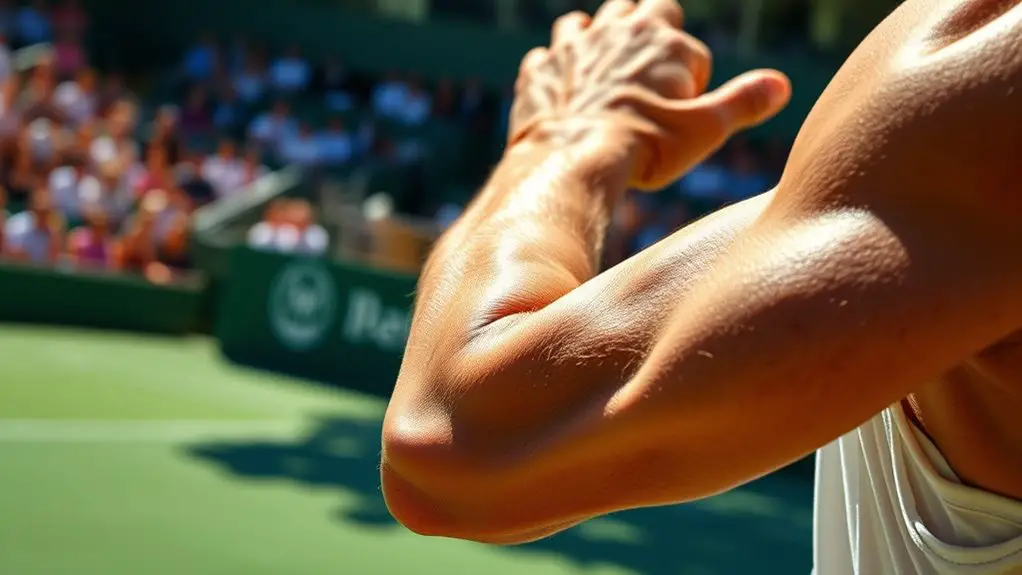To train for faster puck handling and passing speed, focus on mastering basic drills like weaving through cones and stationary puck control exercises. Utilize weighted pucks and shooting pads to enhance strength and simulate real-game conditions. Incorporate advanced techniques such as one-touch and no-look passes to elevate your playmaking skills. Consistent practice builds muscle memory and boosts confidence. Keep exploring different training methods to take your abilities to the next level on the ice.
Understanding the Importance of Puck Handling and Passing Speed
Puck handling and passing speed are essential skills that can make or break a game. When you master puck control, you gain the freedom to navigate the ice like a pro. Imagine weaving through defenders, setting up plays with precision. It's not just about individual flair; it's a critical part of your game strategy. Quick, accurate passes can open up opportunities, turning potential turnovers into scoring chances.
Essential Equipment for Training
To enhance your puck handling and passing speed, having the right equipment is key. You'll want to invest in quality training gear that fits your style and needs. Here's a list of essential items to evaluate:
- Stick Selection: Choose a stick that suits your height and playing style for better control.
- Puck Weight: Training with weighted pucks can build strength and improve your handling.
- Shooting Pads: These provide a smooth surface for off-ice practice, mimicking real ice conditions.
- Training Cones: Use cones to set up obstacle courses that challenge your agility and precision.
- Protective Equipment: Don't forget gear like gloves and shin pads to keep you safe while you train.
Adding practice jerseys to your wardrobe can also help you feel like you're in the game. With the right tools in your arsenal, you'll be on your way to mastering those skills!
Basic Drills to Improve Puck Handling
Improving your puck handling skills can be achieved through a variety of basic drills that focus on control and agility. Start with simple stick handling exercises, like weaving through cones or obstacles. This'll enhance your puck control techniques and help you develop a feel for the puck.
Try using both forehand and backhand while maneuvering through the cones to improve your versatility. Another great drill is the stationary puck control drill, where you practice keeping the puck on your stick while moving it in tight circles.
You can also add speed by incorporating quick starts and stops, simulating game situations. Finally, practice passing against a wall or with a partner to reinforce your stick handling while focusing on puck control. These drills will not only boost your confidence but also give you the freedom to move and react fluidly on the ice.
Advanced Techniques for Quick Passing
While you may have mastered basic passing techniques, incorporating advanced methods can greatly enhance your game. To elevate your quick release and precision passing, consider these techniques:
- One-touch passing: Master the art of receiving and releasing the puck in one fluid motion.
- Sauce passes: Learn to lift the puck over obstacles, ensuring your passes reach teammates without interference.
- No-look passes: Surprise your opponents by passing without staring down your target.
- Bank passes: Utilize the boards to redirect the puck to teammates in difficult situations.
- Fake passes: Deceive defenders by faking your intention before delivering the actual pass.
Incorporating Agility and Speed Workouts
Mastering advanced passing techniques can set you apart on the ice, but without the agility and speed to support those skills, your effectiveness may diminish. To elevate your game, you need to incorporate agility training and speed drills into your routine. These workouts not only enhance your quickness but also improve your overall coordination.
Start with ladder drills to sharpen your footwork and increase your reaction time. Combine these with cone drills to develop direction changes, allowing you to navigate the ice effortlessly. Don't forget to include sprint intervals to boost your acceleration and top-end speed, both of which are essential for breaking away from defenders. Additionally, integrating strength training can enhance your muscle power for directional changes, providing a solid foundation for your agility training.
As you integrate these agility and speed workouts, you'll notice a significant improvement in your ability to handle the puck and make precise passes. Embrace this freedom on the ice, and watch your confidence soar as your skills evolve.
Utilizing Video Analysis for Skill Improvement
As you endeavor to enhance your puck handling and passing speed, utilizing video analysis can be a game-changer. A thorough video breakdown allows you to pinpoint areas for improvement and refine your skills. Here's how to make the most of it:
- Record your sessions: Capture your drills and gameplay to review later.
- Focus on key moments: Identify specific times where your technique falters or shines.
- Compare with pros: Analyze footage of skilled players to see what you can emulate.
- Seek feedback: Share your videos with coaches or peers for constructive performance analysis.
- Track progress: Regularly review old footage to see how far you've come.
Building Consistency Through Repetition and Practice
To improve your puck handling and passing speed, regular drills are key. Consistent practice helps you develop muscle memory and refine your skills. By dedicating time to focused skill development sessions, you'll see noticeable progress in your game.
Importance of Regular Drills
- Boosts muscle memory, making skills second nature
- Enhances your reaction time under pressure
- Increases confidence with the puck
- Develops a rhythm that translates into gameplay
- Allows for tracking progress and adjustments
Focused Skill Development Sessions
While regular practice is essential, incorporating focused skill development sessions can greatly elevate your puck handling and passing speed. These sessions should center around specific techniques you want to improve, allowing for deeper concentration and mastery. By conducting a skill assessment before each session, you can identify areas that need work and tailor your practice accordingly.
During these focused practice sessions, aim for repetition—it's the key to building consistency. Break down your drills into manageable components, so you can refine each skill without feeling overwhelmed. Remember, the more you repeat a technique, the more instinctual it becomes. Embrace the freedom to experiment and adapt in these sessions, as they're pivotal in transforming your abilities on the ice.
Frequently Asked Questions
How Often Should I Practice Puck Handling and Passing Drills?
Imagine you're on the ice, feeling the rush as you effortlessly maneuver the puck. To reach that level, practice frequency is key. Aim for at least three to four sessions a week, focusing on different drills to guarantee skill progression. Mix it up with some game-like scenarios to keep it engaging. Consistency will help you master those skills, giving you the freedom to play with confidence and creativity when it counts.
Can I Train Without Access to Ice?
Absolutely, you can train without access to ice! Dryland training is a fantastic way to improve your puck handling and passing skills. Use off-ice equipment like stickhandling balls or training pads to simulate game situations. You can practice your moves in your backyard or even indoors. The freedom to train anywhere means you can stay sharp, even when you can't hit the rink. Just keep consistent, and you'll see great progress!
What Age Is Appropriate to Start Training for Puck Handling?
You might think it's too early to start training for puck handling, but age recommendations suggest starting as young as five or six. At this age, kids can enjoy the game while developing essential skills. Focusing on skill development early lets you build a solid foundation, fostering a love for hockey. Plus, the freedom to explore different techniques at this age can make learning fun and engaging. So, don't hesitate to get started!
How Can I Measure My Improvement in Puck Handling Speed?
To measure your improvement in puck handling speed, you can track your times using specific puck handling techniques. Set up drills and measure how long it takes you to complete them. Incorporate speed training methods like cone drills and sprints, noting your times weekly. You'll see progress as you refine your skills and boost your confidence. Remember, consistency is key, so keep pushing yourself, and enjoy the freedom that comes with improvement!
Are There Specific Nutrition Tips to Enhance Training Performance?
Imagine fueling a race car; it needs the right gas at the right time. Nutrition timing is essential for optimizing your performance. Eat balanced meals with carbs and protein before and after training. Don't forget hydration strategies; staying well-hydrated improves focus and energy. Aim for water or electrolyte drinks, especially during intense sessions. By prioritizing your nutrition, you'll enhance your training and feel free to push your limits on the ice!




